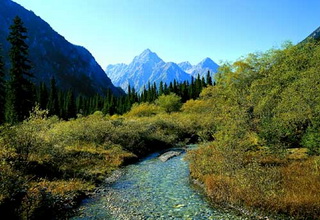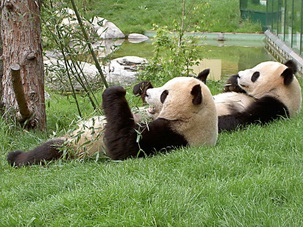
 China Tours
China Tours Tibet Tours
Tibet Tours China Theme Tours
China Theme Tours Off The Beaten Track
Off The Beaten Track Yangtze Cruises
Yangtze Cruises China Trip Planner
China Trip Planner Travel Agents
Travel Agents


We had a wonderful time in Tibet. We have learned a lot about this unique destination because of the wonderful guide Degyi who is so knowledge and always available towards our tours. We stayed at the Shangri-La Hotel Lhasa, and we would never imagine a Tibet travel could be so nice and amazing without the help of Degyi.
Also, thanks a lot to our Tibetan driver Mr.Wongdun for his safe driving and a good sense of service along the way.
We shall return Tibet in the near future!
P.B. and A. A - Europe
Tibet Travel
June 2018 (Private Tibet Journey from Kathmandu)

 The giant panda is the rarest member of the bear family and among the world's most threatened animals. It is universally loved, and has a special significance for the WWF as it has been the organization's logo since 1961, the year WWF was founded.Today, the giant panda's future remains uncertain. As China's economy continues rapidly developing, this bamboo-eating member of the bear family faces a number of threats. Its forest habitat, in the mountainous areas of southwest China, is increasingly fragmented by roads and railroads. Habitat loss continues to occur outside of protected areas, while poaching remains an ever-present threat.
The giant panda is the rarest member of the bear family and among the world's most threatened animals. It is universally loved, and has a special significance for the WWF as it has been the organization's logo since 1961, the year WWF was founded.Today, the giant panda's future remains uncertain. As China's economy continues rapidly developing, this bamboo-eating member of the bear family faces a number of threats. Its forest habitat, in the mountainous areas of southwest China, is increasingly fragmented by roads and railroads. Habitat loss continues to occur outside of protected areas, while poaching remains an ever-present threat.Giant Panda's appearance
The sharply contrasting black and white coloration, added to the stocky characteristic shape of a bear, makes the giant panda one of the most recognizable animals in the world. Pandas look a lot like other bears in terms of general shape and body structure. Because they chew tough bamboo stalks for nourishment, they have highly developed muscles around their jaw and large crushing molars. This makes their heads very round in appearance. When compared with other bears, the head of the giant panda is large in relation to its body.
Panda forepaws are very flexible and have an enlarged wrist bone that acts as a unique 'sixth digit,' which works sort of like a human thumb. Pandas do not have heel pads on their hind feet like other bears, but they can still move around the dense forest silently and easily. The head, top of the neck and rump are white, while small patches of fur around the eyes, the ears, shoulders, front legs, and rear legs are black. 
In the wild their coloring can look more red or brown than black. Pandas have a short tail which is sometimes black. Their fur is thick with coarse outer hairs and dense wooly under-fur. The wrist bone, becoming extended to form an awkward, but functional, opposable thumb. The male genitalia are small and pointed to the rear, which is more similar to the red panda (Ailurus fulgens) than to other bears. Pandas also have an extremely thick esophagus so that they can swallow the large splinters of bamboo. Pandas are the most distinctively marked of all bears.
Giant Panda's Size
Adult giant pandas range in body length from about 160 to 190 centimeters (64 to 76 inches). Males are slightly longer than females, have stronger forelegs, and are 10 to 20 percent heavier. In the wild males weigh from 85 to 125 kilograms (190 to 275 pounds), while females range between 70 and 100 kilograms (155 to 220 pounds). At birth, cubs weigh only 85 to 140 grams (3 to 5 ounces). In captivity they live 25+ years.
Giant Panda Habitat
Giant pandas live at an altitude of between 1,200 and 3,500 meters (4,000 and 11,500 feet) in mountain forests that are characterized by dense stands of bamboo. Home ranges average 8.5 square kilometers (3.3 square miles) for ma les and 4.6 square kilometers (1.8 square miles) for females. They also are in Southwestern China, along the eastern edge of the Tibetan plateau in six small areas in Sichuan, Gansu, and Shaanzi provinces. Prefer to live in cold, damp coniferous forests between 4000 and 11,000 feet high in elevation. Require dense bamboo stands for food and cover. Today pandas exist in only six small areas along the eastern rim of the Tibetan plateau. 
Giant Panda Distribution
Most of the bears that remain in the wild live in a chain of fourteen reserves that were established by the Chinese government. Today, it is estimated that only 700 pandas remain in the wild. There are another 200 of the bears in zoos (mostly in China). Although they were once more widespread, today they are limited to six small areas in Sichuan, Gansu, and Shaanzi provinces, totaling only 14,000 square kilometers (5,400 square miles).
Giant Panda Reproduction
Pandas reproduce very slowly and infant mortality is high. Pandas reach sexual maturity from four-and-a-half to 7 years of age and mate during the spring, from March to May. Females are in estrus for one to three weeks, but peak receptiveness lasts for only a few days. Pandas mate in the spring and the mother usually gives birth to two cubs in the early fall, but often she abandons one and lets it die. Litters of one, two, or occasionally three cubs are born in August or September, usually in a hollow tree or cave. Although cubs are usually weaned at about nine months of age, they remain with their mothers for up to 18 months. Newborn pandas are tiny, only about a quarter of a pound. Cubs usually stay with their mothers until they are a year and a half old.
Giant Panda Community
Except for females accompanied by cubs, giant pandas live a solitary existence. Home ranges for males average 3.3 square miles and 1.8 square miles for females. Home ranges for females are usually mutually exclusive while male pandas may overlap those of several females.
Giant Panda Social System
During the breeding season, several males may compete for access to a female. Pandas communicate by rubbing an acetic- smelling substance-secreted by glands surrounding the anogenital area-onto tree trunks and stones. They also scratch trees. Most territorial marking is thought to be done by males. Pandas are quite vocal and eleven distinct calls have been identified i n the wild, although the function of each is not understood. In captivity, females vocalize during estrus as well.
Giant Panda Diet
More than 99 percent of the food consumed by giant pandas consists of the branches, stems, shoots and leaves of at least 30 species of bamboo, the species eaten varying from region to region. They spend between 10 and 12 hours eating bamboo every day. Adults consume 12 to 15 kilograms (25 to 40 pounds) of food per day when feeding on bamboo leaves and stems, to ingest required nutrients. However, when feeding on new bamboo shoots, they are capable of eating up to 38 kilograms (84 pounds) per day, which is about 40 percent of their average body weight. Although the proportion is small, pandas also feed to a limited degree on other plants and a small amount of meat. When an opportunity may arise, although they are too slow to catch most animals. 
They feed mainly on the ground but are capable of climbing trees as well. They are active mainly at twilight and at night. Is the giant panda more like a bear or a racoon? They certainly look bearish, but they have a few unusual features that led people to believe they are not a bear. After almost a century of debate, scientists were finally able to test the genes from pandas and determine that they are actually a species of bear. Pandas are the rarest of bears. They are found in a wilderness area in China that continues to disappear due to human encroachment.
Giant Panda Behavior
Individual pandas may share the same ranges, but they try to avoid each other and spend most of their time alone. When they are not eating they are usually resting. Most active during dawn and in the early evening.
On a diet of bamboo, it is impossible for panda bears to accumulate enough fat to sleep through the winter. Instead of hibernating in higher, cooler climates the bears go down to lower elevations with warmer weather. Pandas are active mainly at twilight and at night. Eyes adapted for night vision. Considered the domestic animal of the Chinese emperors. Eleven distinct calls have been identified for Pandas in the wild. Typically they don't hibernate even when living in higher elevations.
Place to see Giant Panda in Chengdu, China
Chengdu Research Base of Giant Panda Breeding
The Chengdu Research Base of Giant Panda Breeding is a non-profit organization engaged in wildlife research, captive breeding, conservation education, and educational tourism. The Chengdu Panda Base was founded in 1987, with six giant pandas rescued from the wild. As of 2008 the captive population has increased to 83 individuals from that founding population of only six. Genetic diversity in the population is sustained by the exchange of preserved genetic material with other facilities. The Chengdu Base is very proud that we have not taken any giant pandas from the wild for 20 years. This demonstrates our unique and uncompromising commitment to the conservation of the wild population and the healthy growth of the captive population.
Due to their research and commitment to animal health and welfare, 124 giant panda cubs have been born to the Base in 85 litters, 88 survived and now have 83. To assist other institutions holding giant pandas the Chengdu Base provides technical support and send our experts to assist with care, rearing, and breeding. So that all giant panda researchers can share their knowledge, the base hosts the Giant Panda Annual Technical Meeting, inviting researchers from all over the world to share information to improve captive management for the conservation of giant pandas.
The Chengdu Panda Base covers an area of 106 hectares and will be enlarged to 200 hectares during the third phase of the expansion. Red pandas, golden monkeys and other wild and/or endangered species live and breed here. Come and visit these lovely Giant Panda in the Chengdu Research Base of Giant Panda Breeding!
http://www.panda.org.cn
China Trip Planner | Travel Agents | About Us | Why Us | Contact Us | How to Pay | How to Book - Terms & Conditions | Site Map
Copyright © 2010 - 2030 All Rights Reserved.


 0086-28-85711328
0086-28-85711328 0086-28-85546015
0086-28-85546015



